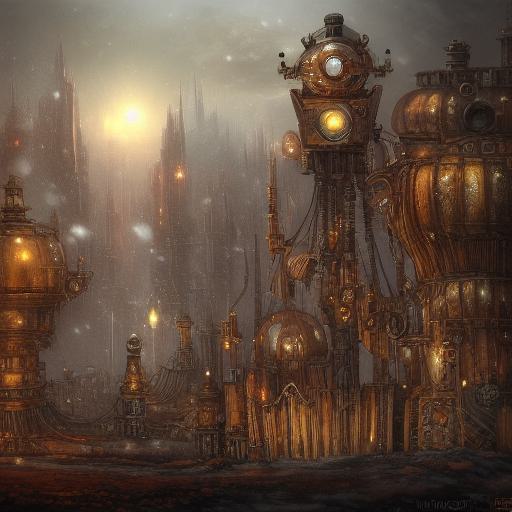How to write this prompt?
How each part contributes to the image being generated.
- “Fantasy” – This sets the overall genre and style for the image being generated. It implies that the image should be imaginative, creative, and not necessarily grounded in reality.
- “Steampunk art” – This further defines the style and aesthetic of the image, indicating that it should be inspired by the retro-futuristic style of the steampunk genre. This means that it should incorporate elements of Victorian-era machinery, gears, clockwork, and other mechanical components.
- “A painting of a mechanical city on top of a mountain with many gears and metallic component” – This describes the main subject of the image. It gives a specific visual reference point for the generator to work with and sets the scene for the rest of the image.
- “At a snowing day” – This sets the weather condition of the image, which adds a sense of atmosphere and mood to the scene. It also suggests that the image should have a colder, wintry tone.
- “Concept art inspired by Brian Despain, Artstation contest winner” – This provides a reference point for the style and composition of the image. It suggests that the image should be similar in style to the work of Brian Despain, who is known for his imaginative, fantastical paintings.
- “Very far royal steampunk castle” – This adds another visual element to the scene, indicating that there is a castle in the distance. This sets the scale of the image and adds another layer of depth to the scene.
- “Science fantasy painting” – This further refines the genre of the image, indicating that it should blend elements of both science fiction and fantasy. This can allow for a wider range of creative possibilities in the image.
- “Steampunk villages castles” – This adds more detail to the image, suggesting that there should be additional steampunk-style buildings in the scene beyond just the mechanical city and royal castle.
All of these elements work together to give a clear and specific vision for the generator to follow when creating the image. By combining these different components, the generator can create a rich, imaginative scene that is consistent with the overall style and aesthetic of the prompt.
What is the origin of steampunk art?
Steampunk art originated in the 1980s as a sub-genre of science fiction and fantasy literature. It is heavily inspired by the Victorian era and typically features advanced steam-powered technology, such as airships and clockwork machinery.
How to create a steampunk-inspired painting?
To create a steampunk-inspired painting, start by researching the genre and gathering visual references. Incorporate elements of Victorian-era machinery, such as gears, pipes, and steam engines, and use a muted color palette with plenty of browns, coppers, and brass tones. You can also add futuristic elements, such as airships or other advanced technology, to give the painting a retro-futuristic feel.
Why is fantasy art popular?
Fantasy art is popular because it allows for a great deal of creative freedom and imagination. It often features fantastical creatures, magical landscapes, and otherworldly scenes, which can be both visually striking and emotionally engaging. Fantasy art can also provide an escape from reality and offer a sense of wonder and adventure.
How can AI-generated art be used in different industries?
AI-generated art can be used in various industries in different ways:
- Advertising and Marketing: AI-generated art can be used to create unique and eye-catching visuals for advertising and marketing campaigns. For instance, fashion brands can use AI-generated images of clothing to promote their products.
- Entertainment: AI-generated art can be used to create realistic 3D models for video games, animation movies, and other media. It can also help to create music videos and other visual content for the entertainment industry.
- Interior Design: AI-generated art can be used to create unique and creative designs for interior spaces. It can help designers to come up with new and innovative ideas for furniture, lighting, and other decor elements.
- Education: AI-generated art can be used in educational materials to create interactive and engaging content. For instance, an AI-generated simulation can be used to teach students about science or history.
- Fashion: AI-generated art can be used in the fashion industry to create unique designs and patterns for fabrics and clothing.
What is the future of AI art generation?
The future of AI art generation is exciting and promising. As AI technology continues to advance, we can expect to see more sophisticated and complex AI-generated artworks. AI art can be used to create new forms of art that are not possible with traditional methods. It can also help to democratize art by making it more accessible to a wider audience. In the future, we may see AI-generated artworks in galleries and museums, and we may even see AI-generated artworks being sold for millions of dollars at auctions.
Looking to add some cutting-edge creativity to your designs? Look no further than Visual Paradigm Online! With our innovative design tools, you can seamlessly incorporate stunning AI-generated art into your graphics with just a few clicks. Our user-friendly interface and extensive range of design templates and assets make experimentation a breeze, so you can explore countless styles and layouts until you find the perfect combination for your project. Elevate your designs to the next level with Visual Paradigm Online today!


